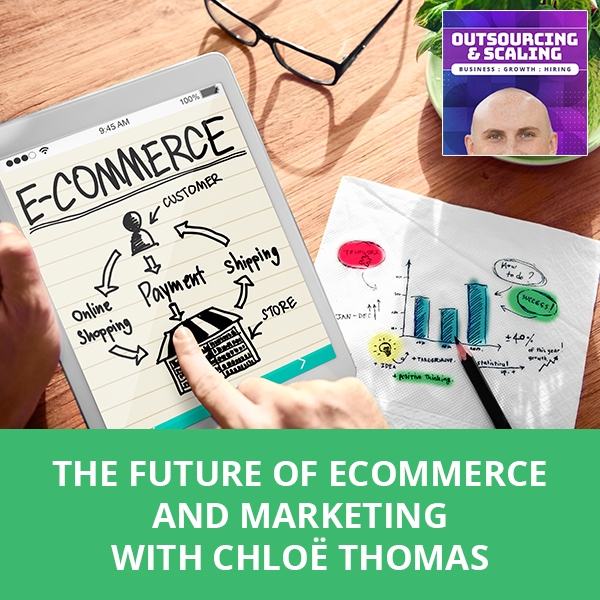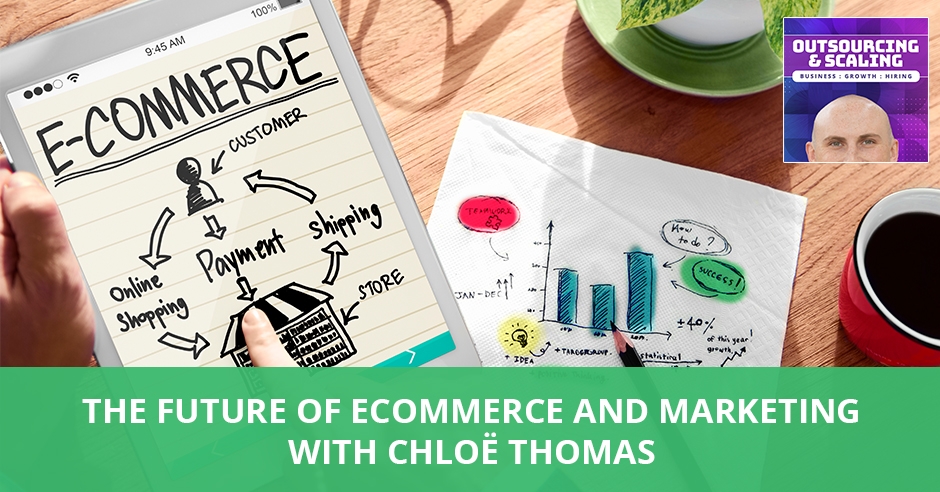


Buying and selling have evolved with the help of technology. We can now buy things quickly at the comfort of our homes with one click and it will be delivered to your doorstep. Even though things change rapidly nowadays, the trend for eCommerce is quite predictable than you would ever think. Chloë Thomas, the founder of eCommerce MasterPlan, international speaker, and bestselling author, demystifies the world of eCommerce. Chloe takes us back to the time she started her first job in eCommerce working for a multichannel retailer. She says technology may have evolved so much, but the challenges remain the same because the customers are not that different. Having worked with a lot of big brands, Chloe takes us into the behind-the-scenes of a product launch, creating a marketing plan for eCommerce, and managing a marketing team, and touches on the future of eCommerce and marketing.
—
Listen to the podcast here:
[smart_track_player url=”https://www.podetize.com/statsapi/www.podetize.com/wp-content/uploads/fileuploads/11-5b145ef137b51b3d1af0633e9305c43d/04/2019/aa92c4bd8d8cbb57a07b412c74a6632f.mp3″ title=”The Future Of eCommerce And Marketing with Chloë Thomas” artist=”Nathan Hirsch” image=”https://freeup.net/wp-content/uploads/2019/04/OAS.png” ]
Download the audio file here.
The Future Of eCommerce And Marketing with Chloë Thomas
We have a special guest, Chloe Thomas. Chloe, how are you?
I’m great, Nathan. I’m excited to be hanging out with you and your audience.
I love hanging out with you. I know Connor, my business partner, me and you, we’ve gone back a few years now. It’s been a lot of fun. Let’s tell our audience a little bit more about you. You’re a bestselling author, international speaker, the host of both the eCommerce MasterPlan Podcast and Virtual Summit. She is one of the Top 50 UK Influencers in eCommerce and Shipping. Her podcast is regularly included in the list of top eCommerce and business podcasts in the world. You’ve been in eCommerce since 2003, which is even longer than I’ve been. What was eCommerce like in 2003? I can’t even imagine because in 2008 when I got in, no one even knew what it was.
My first job in eCommerce was working for a multichannel retailer trying to deal with all those Omni channel craziness. We didn’t have marketplaces then, but we had 120 stores around the UK. That made us quite big in the UK. We had a mail order catalog, which is what I was brought in to run. We had our own website on the IBM WebSphere platform, which was a hulk of a website. We had all the same challenges you have from the marketing and strategy perspective. How do you deal with customers wanting to use lots of different spaces? How do you try and do attribution?
We spent ages wondering about attribution, but many years later we still haven’t solved attribution. I guess the big change is how much more accessible things have happened between now and then. We had to host the website in our offices. At Christmas time, because we sell gifts, everyone in the office apart from the marketing team was banned from using the internet because it slowed down the website. We had a team of five running it, which these days that business would have a Shopify site. The accessibility of technology has evolved so much but the challenges remain the same because the customers are not that different.
Let’s kick it way back. Your childhood, I always love to know where entrepreneurs came from. Were you a straight-A student? Were you a rebel? Did you know you want to be an entrepreneur? Did that come later? You don’t have to give us too much but give us a summary of what you were like.
Make sure you’re making the right decisions where you’re improving things.
I was a fairly boring straight-A student. I got the straight-As at GCSEs, which are the test that we take at age sixteen. It fell apart a little bit of about eight levels but I did manage to get into Oxford University, where I studied history. Entrepreneurism came to me because my third boss post-uni offered me the job of being his head of eCommerce for about six different businesses and the carrot was to turn that into a marketing agency at the end. I was an accidental entrepreneur and several years on, I can’t imagine having a job.
What were you going to be before you went the entrepreneurship route or before you got into eCommerce? I know you studied history. Was there a certain job that you wanted?
No, I studied history because I figured I might as well study something I like. The interesting thing is I use parts of my degree day-in and day-out. The skills I learned while studying history is still very relevant to what I do. I suppose if he hadn’t come along and done that, I would have been on course to be a director of eCommerce for one of the UK’s high street businesses I suppose, but I didn’t take that track. I took this track. It’s probably been an awful lot more fun at the very least.
I worked with a lot of Amazon sellers and as you know, launching a product on Amazon is a lot different than launching a product outside of Amazon. You’ve worked with a lot of big brands who I’m assuming have launched a lot of products. Can you take us into the behind the scenes of a product launch when these big companies are trying to do it?
As in on Amazon or not on Amazon?
Not on Amazon. I think you’re more not on Amazon.

I want to make sure about that before I went off on the wrong tangent. In the non-Amazon world, product launches are so much less of a big thing. You might be talking like a season launch when it comes to a high big fashion retailer. We’ve got some new products, seasons coming and we’ll put the looks together. It’s not that same like, “Here’s my highlighter pen and I need to launch my highlighter pens.” Everything’s focused on this one thing. I often look at the listings for Amazon FBA businesses who are trying to sell. I’m like, “You have three SKUs? How do you cope with three SKUs?” I work in a world of hundreds and thousands of SKUs. It’s about the range and we spend far more time talking about the brand. Product launches don’t come into what we do, but we would do a season launch. I say the new end because new is always a big angle. That involves creating all the new Google ads, all the new email marketing and briefing the affiliates. It’s far more of an all-encompassing project. If they’re also selling on their marketplace, it’s making sure those listings are ready too.
It’s the behind the scenes of the non-Amazon world. Let’s dive into marketing. That’s obviously your core. I’m not a marketer. I have somehow become a marketer working with FreeeUp, but I’ve never done real marketing for eCommerce. I run an Amazon business. I did marketing on Amazon and even back in the days at Amazon, there was no external traffic like running Facebook ads, Amazon, that didn’t exist. When you come into a business and you’ve run lots of different eCommerce business and you look at these thousands of SKUs, how do you create that marketing plan? What’s the starting point? Walk us through that.
The starting point for me with any marketing plan and working out, let’s say you’re working out for the next quarter, back when I started, we looked at the whole year but that’s insane these days. We look at the next three months.
Is a quarter pretty normal?
You’ve probably got your eye out for the Black Friday and the Christmas stuff but the detail you don’t need to a quarter at a time these days. The first thing you’re going to do is look at your previous results. The last quarter and this quarter last year. If we’re talking Q1, let’s say, January, February, March, we’d look at October, November, December. We’d look at January, February, March of last year to see what worked and what worked in the same season last year. Take those marketing methods that were strong. Maybe we were talking email, we’re talking Facebook, maybe Facebook Ads. We’re probably talking social media content, whatever worked and drove the sales in those two quarters is what you’re going to focus on.
You’re going to focus on your methods. I usually go and catch up with the merchandising team. The people who are in charge of the products, the buying and merchandising. What’s coming and what we think is going to be a big story. In the world of fashion, it might be a particular trend or if you’re talking in the gifts business, it might be this particular gadget or this particular item that we think is going to be our best sellers. Those guys are usually pretty good at predicting that thing. They would probably be the ones who decide when we’re doing a big discount weekend or when we’re going into the sale. Those are the big things that you’re going to hang the quarter off. Then underneath that we’re then tasked in marketing with what we’re going to say in each email.
If you try and keep it to one meeting a week, it gives your team enough time to be creative and to feel inspired.
What the focus of the Google ads is going to be and what the Facebook strategy is going to be. We have to work with that and test the measure as we go through the season to make sure we’re making the right decisions and we’re improving things. We also have lots of ongoing builds. We have to do the automation. Welcome campaigns need to be updated. Maybe we’re building a new browse trigger campaign. People have looked at these categories who are on our database and they haven’t done anything with us in six months. We’re going to ping out some emails to them. All that asset-building element of marketing rather than the things which are happening, that has to go on as well. It’s a massive juggling act but a very satisfying one.
Not only is it massive on the work, it’s probably a lot of people. You’ve got the graphic designers, you’ve got the writers, you’ve got all these people and you’re up here directing it. A lot of the people reading this that are clients of FreeUp or that are running their own business, sometimes they struggle to put all those pieces together to get that good marketing plan. Any advice there on managing a marketing team that consists of a lot of creatives that aren’t necessarily the easiest to work with if you’re a business owner?
I find that the more people you’ve got involved and the more you want to take advantage of the great skills of those people, the more organized you have to be. You can’t go, “It’s Friday. Next week, what are we going to put out?” and think that your copywriters, your agencies, your graphic designers, your team are going to be able to do a good job of it. They can when they need to, but you should try and set them up a little bit more for success. I interviewed one of the content managers from HelloFresh in the USA. I think it was after the podcast. She was writing blog content for the HelloFresh website and they were working six months ahead. She was writing things and researching things that weren’t going to go live for three to six months because they knew what the trends were, which for me was slightly mind-blowing.
How do you know what the trends are in six months? Things change so fast.
That’s the thing, they do change but they don’t change. They are quite predictable and they’re more predictable than you would think. There are people whose job is to work out what these trends are, but they’re working so far ahead. You’ve got to give them time to get it right. You have to meet with the team, a regular schedule of meetings. Every Monday we get together, we look at the plan. We double check if we can still deliver on what we need to do this week and that it’s still the right thing to be done. The plan you create in December for January, February, March, will also by the time you get to March and that’s okay.
We’re perfectly happy with that happening, but you can’t be writing as you go along. You can be amending as you go along, but you can’t be writing as you go along. That regular Monday meeting where you get everybody in and you’re right, where are we? Where are we on this week’s projects? Where are we on next week’s projects? Where are we on Black Friday if we need to be worrying about Black Friday? Just to sense check and get everyone in the same room, it’s such an efficient way of doing it and has it all out on a Trello board or an Asana board or something so you’re managing those pieces. Those are the quick tips.

You touched on my next question, which was meetings. How many meetings? I’m assuming you don’t just say, “Go run with it. I’ll talk to you in a month.” Is it once a week or is it more than once a week?
My favorite thing to do is to have a weekly marketing meeting. Then if I’ve got direct reports at the moment in time, I will have a meeting with each of those each week as well to see how it goes. In my retailers’ businesses, they would be following that. In my business, I have a few freelancers dotted around to do two different things with me. They come in for a project or go for a project. With them, I’m catching up when I need to, but not in the times when they’ve got less to do. You have to be there, but you also have to trust in your team. What I find is that if you try and keep it to one meeting a week, it gives your team enough time to be creative, to feel inspired, to feel that they’re doing something great, but it doesn’t give them enough time to screw up to put it bluntly.
Let’s talk about eCommerce and marketing in 2019. Where do you think it’s going? What mistakes do you see that people are making that maybe they’re not adjusting to the times?
One of the ones who continued to bombast and confused me is how many of the larger players aren’t using Facebook Ads. It’s slowly creeping up there, but I still find a lot of big businesses haven’t quite yet got their head around it. They’re trying to apply Google ads mechanism to Facebook ads but they work too differently. That’s one thing which you can get ahead of the pack, get ahead of your competitors if you’re doing Facebook ads well. There’s also the technological adoption. It’s one of the pieces people are struggling with. I’ve surveyed my audience, my podcast listeners, my email sign-up guys and 65% of them either are or considering switching email marketing platform in 2019, which is huge.
From what to what?
The majority of them are on MailChimp.
You can still get ahead of the pack or your competitors if you’re doing Facebook ads.
I’m on MailChimp. What are they switching to?
I didn’t ask them that, but the ones I hear people switching to at the moment would be Klaviyo and Omniscient and a few are switching to Drip by Leadpages as well. Those seem to be the ones where people are moving to because they want all that automation. They want things to be easier. If you go to those eCommerce focus systems, the tools are there and those templates there, which there’s nothing worse than, “I’m still working on a campaign, but I’m not quite sure what to do.” On those platforms, you can go welcome campaign and it goes, “This is what you should do.” You get to fill in the gaps and it’s so much easier. Upscaling your tag/making use of the tech you’re paying for is one of the things which people who I see succeeding are doing quite well this 2019.
Let’s change gears a little bit. Talk to me about Chloe Thomas in 2019. What are you working on? I know you’ve got the podcast. I know you’ve got the Summit. I’m assuming you’ve got other stuff outside of that. How do you manage all your time balancing all these different things?
My business is getting quite complicated. A few years ago I sold my marketing agency, which meant I could focus on eCommerce MasterPlan full-time, which has been awesome. One of my primary goals with eCommerce MasterPlan is to do stuff I enjoy, not just stuff that pays the rent. That has led to this slightly bizarre business structure, where about a third of what I do is working with actual retailers to help them solve their marketing problems. Everything from coaching and consulting through to running the Summit or helping them listen to the podcast. There’s about a third of what I do, which is content creation. There’s the Summit and I know Connor is one of the speakers in the next Summit, which comes up in April. I create the books and I create the podcast. Those are all the outlets to help people solve their own marketing problems. Then the other third of what I do is to work for businesses who are trying to sell to eCommerce businesses and retailers.
For them, I write and I speak at conferences. I chair events and that sort of thing. It’s quite complex and there’s only me in the business because I quite like it that way. I’m sure this would be music to your ears. I have a number of outsourced freelancers who helped me with the stuff I know I shouldn’t be doing and the stuff that if I was left to do it would be left until 5:00 on a Friday and probably will not happen. That would be things like graphic design, my social media posting, my podcast editing and those which I cannot get organized. Then the other thing which helps me to manage my time is a cool booking schedule link thing. I never quite sure what to call them, but click here to book some time with me. That saves so much time and effort. Without one of those, I don’t think I could do it.
I’m the same way with my calendar on the site. I wake up every day, every hour is booked and every half an hour is booked. You go through the day and if I want to work on a project, I go in and I book my time there so I can use it. It works out pretty well. What did I miss? What should people know about marketing? What’s new about eCommerce in 2019 that people might be missing the boat or something cool that you’ve come across? I know that you meet a lot of different people and influencers. Give us something cool that’s going on that the average person wouldn’t know.

I think the average person is scared of this. I did some tests with this in January with a couple of retailers and proved that customers don’t mind you doing this and it can be highly lucrative. What am I talking about? Browser push notifications. When you go onto a website, something pops up and it says they would like to contact you, click allow or don’t allow. You do that one click and then you get a pop up every now and again from them telling you a new blog post has gone live. The news, blogs and platforms seem to be a lot more using this software than the eCommerce businesses are. I saw some interesting case studies in the middle of 2018 about it. I decided to test it with a couple of businesses over the Christmas period.
The one which blew my mind with the group that I was doing the testing with was a company called Serious Readers. They are British business, quite a big business actually. They sell reading lights for those who either have a craft that involves focusing on something like model creation, needlework or those whose eyesight is failing and wants to be able to read the newspaper. That light started about £150. That’s about $250 per light and they go up in price. They have a very old audience. The majority of their sales come through on the desktop, not mobile, which is relevant for their demographic not because of anything else. Because they’re older demographic and because they’re buying that highly-priced product, my assumption was that push marketing was all about the knee-jerk impulse sale. The results were phenomenal.
We’ve got a 13% conversion rate from one of the campaigns we ran. It’s mental and we started from zero because you don’t have any subscribers until you turn it on. We earn £4 per subscriber in those two months we were running it, which for a standing start is really good. The other thing is the marketing we were sending was helpful messages and content-based messages. They put a blog up about glaucoma, done some of the latest research on glaucoma and that’s what we put in our push notification. We wrote, “Here’s the latest news about glaucoma and XYZ is happening.” It converted and I’m like, “Really?” It was absolutely fascinating and we didn’t have one single customer service complaints about either the popup or the alerts as they were coming through an audience, which you would have thought would be the least likely to want the browser push notifications.
Often, these days it’s something which is included within email marketing platforms. There’s a strong chance that those people who are reading this have already paid for it. They’re just not using it and haven’t deployed it. That’s a big tip for me this 2019 is to give browser push notifications a try because they are powerful and you have a lot more control over how much they annoy the customers than you might think. You can make them very unannoying and they can drive great sales for your business. That would be my top tip.
Chloe, how can people find out more about you and tell us about the Summit.
You can find out more about me at eCommerceMasterPlan.com. You’ll find out everything I’m doing and how to get in contact. The Summit is going live on the 30th of April. It is available to sign up for free throughout April, so you can get it completely for free. We are focusing on the world of subscription eCommerce, which I think is one of the most exciting things in eCommerce at the moment. There’s huge growth because not only the tech is now there to make it easy for us as retailers to deploy and create a subscription business, but consumers are loving it. They’re loving it in ever greater numbers. If you want to find out how to launch, how to grow, how to retain customers in the world of subscription, I’ve got some amazing speakers.
Some people who are running subscription businesses themselves and I’ve got the best of the subscription suppliers. I’ve got ReCharge coming on. I’ve got FreeUp coming on, for all your outsourcing needs. I’ve got one of the top Shopify agencies in the UK speaking. I’ve got a viral marketing specialist. I’ve got email marketing is covered. I’ve got the guys from Subbly, which is one of the subscription platforms coming on. It’s the content. I’m already partway through recording it, so I can say this hand on heart, it’s really good. You want to get this. You could have three days to watch the whole thing for free. You can find all of that at eCommerceMasterPlan.com/Summit.
If you want to build your brand, if you want to get off Amazon and market and grow your business, check out Chloe’s podcast. Check out the Virtual Summit. Chloe, thanks so much for coming on.
Thank you. It’s been a pleasure.
Important Links:
- Chloe Thomas
- eCommerce MasterPlan
- HelloFresh
- Trello
- Asana
- MailChimp
- Klaviyo
- Omniscient
- Drip
- Serious Readers
- eCommerceMasterplan.com
- Shopify
- ReCharge
- eCommerceMasterPlan.com/Summit
- Subbly
- Virtual Summit
About Chloë Thomas
 Bestselling Author, International Speaker, and host of both the eCommerce MasterPlan Podcast and Virtual Summit.
Bestselling Author, International Speaker, and host of both the eCommerce MasterPlan Podcast and Virtual Summit.
Chloë is one of the Top 50 UK influencers in eCommerce and Shipping (Scurri 2019), and the podcast is regularly included in lists of the top eCommerce & business podcasts in the world.
Chloë Thomas has been in eCommerce since 2003, she’s worked client-side, agency-side, and adviser-side. Working with a wide variety of retailers from high street omnichannel operations, to fresh online only start-ups, covering international launches, subscription, B2B and even dabbling in marketplaces.
Chloë’s speciality is solving eCommerce Marketing Problems from how to increase new customer acquisition, to improving the performance of email marketing newsletters, or finding the right new website provider.
